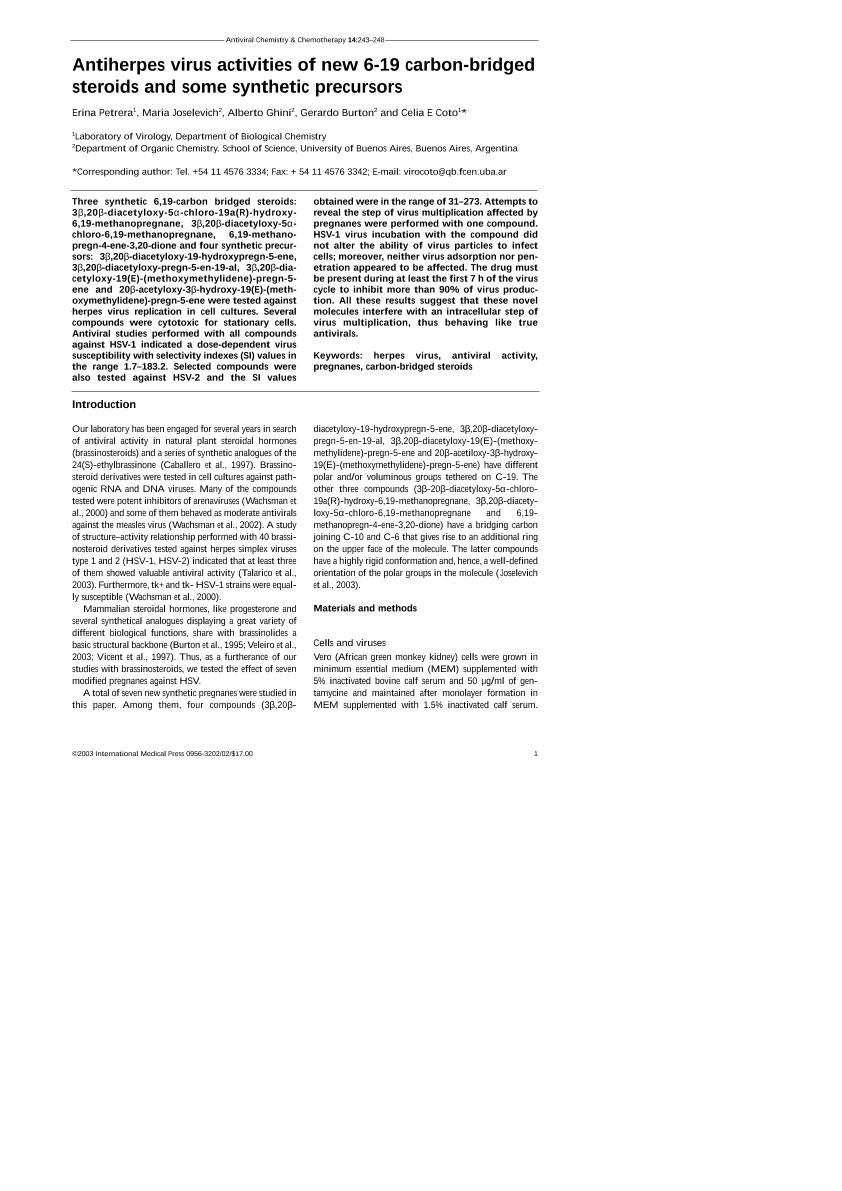Artículo
Antiherpes virus activities of new 6-19 carbon-bridged steroids and some synthetic precursors
Fecha de publicación:
09/2003
Editorial:
International Medical Press
Revista:
Antiviral Chemistry & Chemotherapy
ISSN:
0956-3202
Idioma:
Inglés
Tipo de recurso:
Artículo publicado
Clasificación temática:
Resumen
Three synthetic 6,19-carbon bridged steroids: 3β,20β -diacetyloxy-5α-chloro-19a(R)-hydroxy-6,19-methanopregnane, 3β,20β-diacetyloxy-5α-chloro-6,19-methanopregnane, 6,19-methanopregn-4-ene-3,20-dione and four synthetic precursors: 3β,20β-diacetyloxy-19-hydroxypregn-5-ene, 3β,20β -diacetyloxy-pregn-5-en-19-al, 3β,20β -diacetyloxy-19(E)-(methoxymethylidene)-pregn-5-ene and 20β -acetyloxy-3β-hydroxy-19(E)-(methoxymethylidene)-pregn-5-ene were tested against herpes virus replication in cell cultures. Several compounds were cytotoxic for stationary cells. Antiviral studies performed with all compounds against HSV-1 indicated a dose-dependent virus susceptibility with selectivity indexes (SI) values in the range 1.7-183.2. Selected compounds were also tested against HSV-2 and the SI values obtained were in the range of 31-273. Attempts to reveal the step of virus multiplication affected by pregnanes were performed with one compound. HSV-1 virus incubation with the compound did not alter the ability of virus particles to infect cells; moreover, neither virus adsorption nor penetration appeared to be affected. The drug must be present during at least the first 7 h of the virus cycle to inhibit more than 90% of virus production. All these results suggest that these novel molecules interfere with an intracellular step of virus multiplication, thus behaving like true antivirals.
Palabras clave:
ANTIVIRAL ACTIVITY
,
CARBON-BRIDGED STEROIDS
,
HERPES VIRUS
,
PREGNANES
Archivos asociados
Licencia
Identificadores
Colecciones
Articulos(UMYMFOR)
Articulos de UNID.MICROANAL.Y MET.FISICOS EN QUIM.ORG.(I)
Articulos de UNID.MICROANAL.Y MET.FISICOS EN QUIM.ORG.(I)
Citación
Petrera, Erina; Joselevich, Maria; Ghini, Alberto Antonio; Burton, Gerardo; Coto, Celia Esther; Antiherpes virus activities of new 6-19 carbon-bridged steroids and some synthetic precursors; International Medical Press; Antiviral Chemistry & Chemotherapy; 14; 5; 9-2003; 243-248
Compartir
Altmétricas




